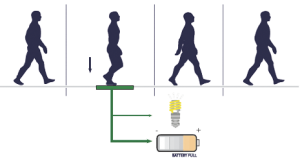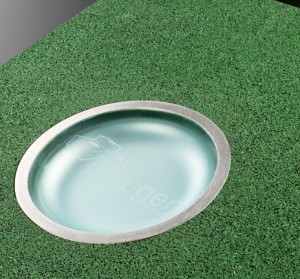A Step in the Right Direction: A New Power Generation Strategy
The world today is constantly struggling to find new, environmentally friendly ways to generate energy. The major power sources today include oil, gas, coal, hydroelectric, and nuclear power. Until recently no one has thought to use everyday life to help generate usable energy.
Laurence Kembell-Cook, director of Pavegen Systems, has had the ingenious idea to harvest electrical energy from pedestrian’s footsteps. He is going to use sidewalk tiles that will be connected to a lithium battery to supply energy to electrically powered devices in the surrounding area. This could range from traffic lights to advertisement boards on sidewalks or supply energy to light up displays at the mall.
The basic design is outlined in Figure 2 and a demonstration of the Pavegen tile system can be found online . The pedestrian will step on the tile, displayed in Figure 3, which will cause it to glow, just like the tiles in Michael Jackson’s “Billie Jean” music video. The five-millimeter compression will initiate a mechanism (unreleased to the public) which allows the kinetic energy to by converted to usable electricity. The tile can also store the energy for up to three days in an onboard battery. Each step on one of these tiles contributes 2.1 W per hour of electricity. Out of the energy the tile absorbs, only five percent goes into lighting up the tile leaving 95 percent of the energy to be used elsewhere. Personally, I believe the energy to light the tile is significant as it gives people a positive reinforcement,which may increase their participation. However,
it also could be argued that energy lighting the tile is wasting energy that could be used elsewhere which I also recognize. The tile itself is made of nearly 100 percent recycled materials, mostly consisting of rubber and some stainless steal which both contribute to its durability. These tiles are designed to be weather resistant, water-resistant, and are easily added to existing structures. The company claims the lifespan of each tile is approximately 5 years or 20 million steps.
The first commercial application will be placing 20 tiles across a very busy intersection in London between London’s Olympic stadium and the newly opened Westfield Stratford City mall. The opening of the mall alone is estimated to bring in around 30 million customers within the first year, that’s a lot of steps!
The aim of this project it to collect a small amount of energy from a large number of people. The growth of this technology will rely heavily on the tiles production costs. If this project gets approved the company hopes to introduce this technology into subway stations, malls, or any other high traffic areas. I believe this would be a fantastic venture for our society so we can finally take a stand, or a stroll, towards helping generate clean energy in the future.





October 24th, 2011 at 4:47 pm
This looks like a very cool idea! These tiles could become an attraction to the mall, which is a lot to say of tiles. Futuristic as it may look, would this technology be any more efficient than solar panels? I’d imagine a strong solar panel can be fashioned into a tile as well for the same purpose in outdoor areas. It’d be interesting to see if the technologies can be mixed to make regular floors a thing of the past.
October 24th, 2011 at 6:56 pm
I cant believe no one has thought about using ‘pedestrian power’ to create energy! its definitely an ingenious idea. I guess this would only work in area that are densely populate with a high foot traffic. Imagine if they were placed in busy areas like subways, bus stops and busy roads, the amount of power possible would be endless!
October 29th, 2011 at 11:12 pm
Wow! That’s a genius idea! It’s impressive how they use recycled materials because that makes it even more environmentally friendly. Having this kind of a start can lead to infinite possibilities perhaps on a much grander scale.
October 30th, 2011 at 10:52 am
This is an amazing new way of creating energy in our daily lives! I recently listened a Ted Talk and this scientist was developing a way to convert light energy absorbed in the windows into electrical energy. He was simply using what we had in our homes and converting to something that is so powerful that we no longer would need to burn fossil fuel anymore. Similarly, this idea that energy can be created simply by using people stepping on the tile, we can reduce our carbon footprint significantly.
October 30th, 2011 at 11:45 am
Awesomesauce! Who knew that generating energy could be so shiny? 😛
The last diagram reminded me of a set of piano stairs installed in Sweden that encouraged people to take the stairs instead of the escalator. https://www.youtube.com/watch?v=2lXh2n0aPyw
October 30th, 2011 at 9:43 pm
Wow, that is an ingenious idea.
Steps like that could be used all over UBC. I wonder if this has been considered for the new CIRS building on campus. It would definitely help them achieve their goal of being carbon negative.
November 4th, 2011 at 5:21 pm
It’s a great idea and a product!
However, I’d like to ask if you think it would be economically beneficial.As in, would the energy created offset the amount of labor costs involved in installing and maintaining the Pavegen tiles? A gain of 2.1 Watts per hour per step from the tiles isn’t much, since the current electricity rate is at 6.67 cents per kwh. It would take 476 steps per hour to save 6.67 cents.
It’s interesting to find out that each of our steps equals to 2.1Watts per hour!